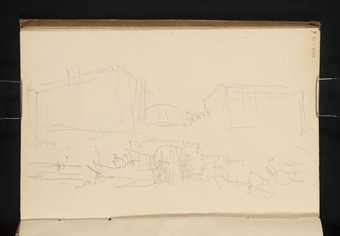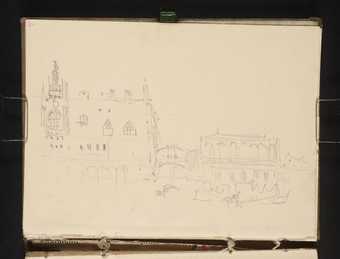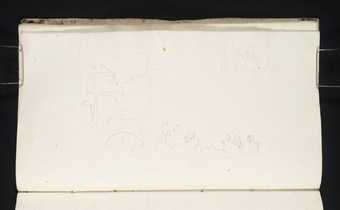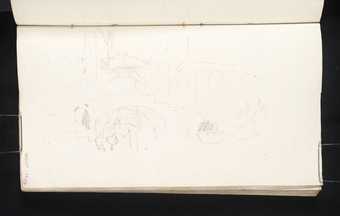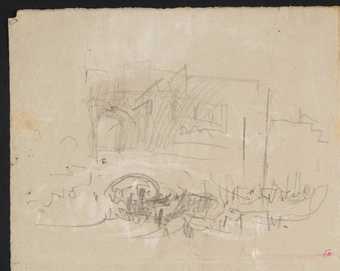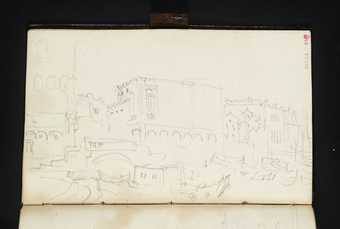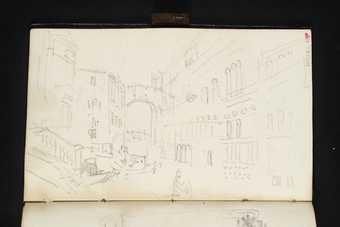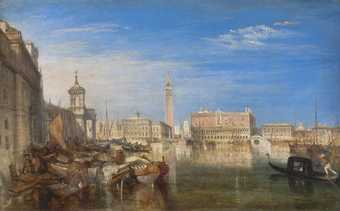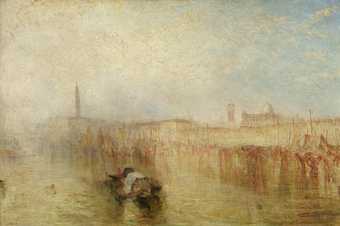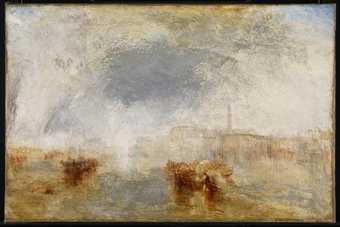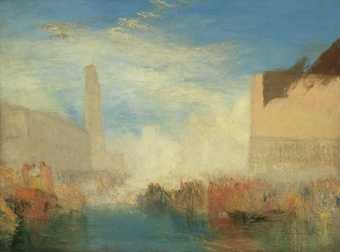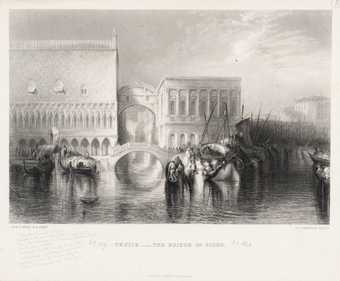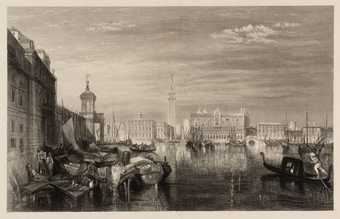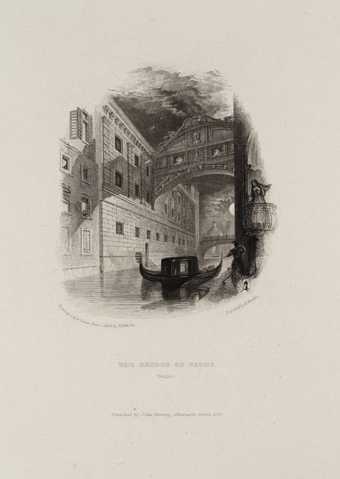
In Tate Britain
- Artist
- Joseph Mallord William Turner 1775–1851
- Medium
- Oil paint on canvas
- Dimensions
- Support: 686 × 914 mm
frame: 868 × 1171 × 129 mm - Collection
- Tate
- Acquisition
- Accepted by the nation as part of the Turner Bequest 1856
- Reference
- N00527
Display caption
Byron was Turner’s favourite modern poet. He illustrated Byron’s Life and Works for the publisher John Murray, and painted six pictures citing Byron’s long poem Childe Harold’s Pilgrimage (published from 1812). Byron was a champion of liberty and independence across Europe. He wrote movingly about Venice, where he lived on and off between 1817 and 1820. To Byron’s disgust, the once-splendid republic had been handed to the Austrian empire after the Napoleonic Wars. Turner exhibited this picture of the Bridge of Sighs, Doge’s Palace and prison with a couplet adapted from Byron: ‘I stood upon a bridge, a palace and / A prison on each hand’.
Gallery label, November 2022
Does this text contain inaccurate information or language that you feel we should improve or change? We would like to hear from you.
Catalogue entry
383. [N00527] Venice, the Bridge of Sighs Exh. 1840
THE TATE GALLERY, LONDON (527)
Canvas, 24 × 36 (61 × 91·5)
Coll. Turner Bequest 1856 (one of 18–21, 36–40; see below); transferred to the Tate Gallery 1961.
Exh. R.A. 1840 (55); R.A. 1974–5 (530, repr.).
Lit. Ruskin 1857 (1903–12, xiii, pp. 158–9); Thornbury 1862, i, p. 346; 1877, p. 465; Bell 1901, pp. 138–9 no. 219; Armstrong 1902, p. 234; Finberg 1930, pp. 103, 112, 132, 156, pl. 19; Davies 1946, pp. 151, 186; Davies 1959, pp. 97–8; Finberg 1961, pp. 379, 505 no. 531; Lindsay 1966, pp. 174, 246 no. 34; Gage 1980, p. 176.
Exhibited in 1840 with the following lines based on Byron's Childe Harold's Pilgrimage, Canto iv, verse I:
‘I stood upon a bridge, a palace and
A prison on each hand.’—Byron
In Byron's original text the lines read,
I stood in Venice, on the Bridge of Sighs;
A palace and a prison on each hand:...
The lines show that Turner saw even the beauties of Venice as a sham, concealing the grim realities on which her departed glories had depended.
Most of the critics of the 1840 R.A. exhibition were so shattered by Turner's other contributions that they failed to mention the two Venetian scenes, this picture and the Venice from the Canale della Giudecca, Chiesa di S Maria della Salute, &c (No. 384). Even the critic of the Spectator, who did notice them on 16 May, could not forbear to include them in his general condemnation of ‘mere freaks of chromomania’, the Venetian pictures being included with their ‘sundry patches of white and nankeen, with a bundle of gayer colours... intended to represent buildings and vessels’.
Nos. 383 [N00527], 402 [N00535], 406 [N00534], 411 [N00539], 413 [N00540], 416–19 [N00541-N00544] appear in the 1854 Schedule as nos:
18 and 19, ‘2 Views of Venice in one frame’ each 3'0" × 2'0";
20 and 21, ‘2 d0 d0 d0’ each 3'0" × 2'0";
36 and 37, ‘2 pictures of Venice in one frame’ each 3'0" × 2'0";
38, ‘View in Venice’, 3'0" × 2'0";
39 and 40, each ‘Ditto’ and each 3'0" × 2'0".
Published in:
Martin Butlin and Evelyn Joll, The Paintings of J.M.W. Turner, revised ed., New Haven and London 1984
Explore
- architecture(30,960)
-
- bridges and viaducts(4,123)
-
- bridge(3,989)
- features(8,872)
-
- arcade(212)
- industrial(2,075)
-
- canal(589)
- periods and styles(5,198)
-
- Gothic(1,186)
- medieval(2,330)
- Renaissance(131)
- townscapes / man-made features(21,603)
-
- waterfront(1,186)
- group(4,227)
- Italy(4,473)
- transport: water(8,015)
-
- boat - non-specific(2,203)
- boat, gondola(166)
You might like
-
Joseph Mallord William Turner The Palazzo Ducale (Doge’s Palace) and New Prisons, Venice, from the Bacino, with the Bridge of Sighs beyond the Ponte della Paglia
1840 -
Joseph Mallord William Turner The Palazzo Ducale (Doge’s Palace), Venice, with the Bridge of Sighs and Prisons, from the Bacino
1840 -
Joseph Mallord William Turner Gondolas on the Bacino near the Ponte della Paglia, Venice, with the Bridge of Sighs Beyond
1833 -
Joseph Mallord William Turner The Ponte della Paglia and Bridge of Sighs from the Bacino, Venice, with Figures and Boats
1833 -
Joseph Mallord William Turner Shipping off the Ponte della Paglia, Venice, with the Bridge of Sighs Beyond
1840 -
Joseph Mallord William Turner The Bridge of Sighs and Palazzo Ducale (Doge’s Palace), Venice, from the Ponte della Canonica on the Rio del Palazzo
1840 -
Joseph Mallord William Turner Bridge of Sighs, Ducal Palace and Custom-House, Venice: Canaletti Painting
exhibited 1833 -
Joseph Mallord William Turner Venice Quay, Ducal Palace
exhibited 1844 -
Joseph Mallord William Turner Venice - Noon
exhibited 1845 -
Joseph Mallord William Turner Venice, the Piazzetta with the Ceremony of the Doge Marrying the Sea
c.1835 -
After Joseph Mallord William Turner Venice
1830 -
After Joseph Mallord William Turner Venice - the Bridge of Sighs, engraved by Armytage
published 1859–61 -
After Joseph Mallord William Turner Bridge of Sighs, Ducal Palace and Custom-House, Venice: Canaletti Painting, engraved by T.A. Prior
1850 -
After Joseph Mallord William Turner The Bridge of Sighs, Venice, engraved by E. Finden
published 1832–4

